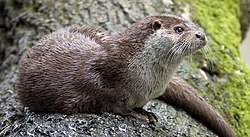Order: Carnivora (carnivorans)

- Suborder: Caniformia
- Family: Canidae (dogs, foxes)
- Family: Mustelidae (mustelids)
- Genus: Mustela
- Least weasel, M. nivalisLC [6]
- Genus: Lutra
- Eurasian otter, L. lutraNT [7]
- Genus: Mustela
This is a list of the mammal species recorded in San Marino. There are nine mammal species in San Marino, of which one is near threatened. [1]
The following tags are used to highlight each species' conservation status as assessed by the International Union for Conservation of Nature:
| EX | Extinct | No reasonable doubt that the last individual has died. |
| EW | Extinct in the wild | Known only to survive in captivity or as a naturalized populations well outside its previous range. |
| CR | Critically endangered | The species is in imminent risk of extinction in the wild. |
| EN | Endangered | The species is facing an extremely high risk of extinction in the wild. |
| VU | Vulnerable | The species is facing a high risk of extinction in the wild. |
| NT | Near threatened | The species does not meet any of the criteria that would categorise it as risking extinction but it is likely to do so in the future. |
| LC | Least concern | There are no current identifiable risks to the species. |
| DD | Data deficient | There is inadequate information to make an assessment of the risks to this species. |
